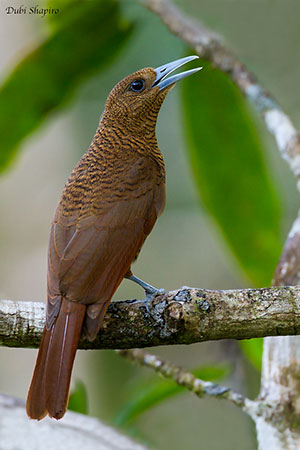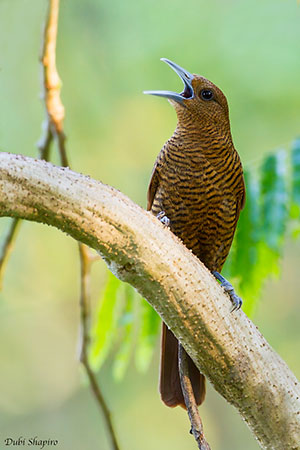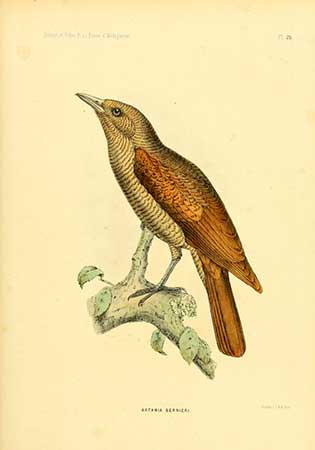
The female lays 3 pinkish-white eggs with darker mottling towards the larger end. Both adults incubate during 17 days, with help of the immature male but to minor extent. The chicks are brooded and fed by both parents with invertebrates and small vertebrates, but usually mainly with insects. The young fledge 17 days after hatching.
The Madagascar Harrier-Hawk may take the eggs in the nest, involving nest failure.
PROTECTION / THREATS / STATUS:
The Bernier’s Vanga has restricted range in NE Madagascar. It is rather rare throughout this range, or uncommon and patchily distributed.
It is threatened by habitat loss through forest clearance, degradation and increase of human population. The remaining forest at lower elevations will probably disappear in next future.
The population is estimated to number 2,500/9,999 mature individuals, equating roughly to 3,500/15,000 individuals. This population is suspected to be declining due to habitat destruction.
The Bernier’s Vanga is currently classified as Vulnerable.
Fr: Oriolie de Bernier
Ang: Bernier's Vanga
All: Schwarzvanga
Esp: Vanga de Bernier
Ita: Vanga di Bernier
Nd: Zwarte Vanga
Sd: berniervanga
Mal: Taporo
Photographer:
Dubi Shapiro
Dubi Shapiro Photo Galleries & Dubi Shapiro's Pictures on IBC
Illustrator:
John Gerrard Keulemans (1842-1912)
Illustration origin (Published in 1868)
Text by Nicole Bouglouan
Sources:
HANDBOOK OF THE BIRDS OF THE WORLD Vol 14 by Josep del Hoyo-Andrew Elliot-David Christie - Lynx Edicions – ISBN: 9788496553507
Birds of Madagascar and the Indian Ocean Islands Par Roger Safford, Adrian Skerrett, Frank Hawkins – ISBN: 1472924118, 9781472924117- Editeur: Bloomsbury Publishing, 2015
The Birds of Africa: Volume VIII: The Malagasy Region: Madagascar, Seychelles, Comoros, Mascarenes - Par Roger Safford, Frank Hawkins – ISBN: 1408190494, 9781408190494- Editeur: A&C Black, 2013
Creagus – Bird Families of the World – Vangas - Vanginae
THE VANGAS OF MADAGASCAR by Nick Garbutt
Vanga - From Wikipedia, the free encyclopedia
Annales des sciences naturelles: Zoologie et biologie animale – Genre Oriolia
Bernier’s Vanga
Oriolia bernieri
Passeriformes Order – Vangidae family
INTRODUCTION:
The Bernier’s Vanga is endemic to Madagascar. It is the sole member of the genus Oriolia and the species is sexually dimorphic. It occurs in the lowland evergreen humid forest in NE Madagascar.
This species is able to cling to almost vertical tree trunks like a woodpecker, thanks to the sharp, strongly curved claws. Alongside other vanga species, the Bernier’s Vanga fills niches that are occupied by Picidae in other parts of the world.
The Bernier’s Vanga is threatened by loss and degradation of forest habitat, involving decrease of the population. In spite of its presence in several protected areas, the future of this species is threatened with increasing human population and forest destruction. It is currently classified as Vulnerable.
DESCRIPTION OF THE BIRD:
Biometrics:
Length: 23 cm
Weight: 52-59 g
The Bernier’s Vanga adult male has black plumage overall with blue-green sheen on head, body, tertials, upperwing-coverts and uppertail. The flight feathers are brownish-black but the secondaries have narrow black edges.
On the underparts, the underwing-coverts are black with blue-green sheen. The undertail feathers are blackish-brown.
The stout, conical bill is pale blue-grey. The eyes are greyish-white. Legs and feet are pale grey.

The Bernier’s Vanga adult female has dark, tan-rufous plumage. On upperparts and breast, almost all feathers are finely barred black, forming spotted or scaled pattern. This colour is brighter on the wings. The uppertail is rufous-brown whereas the underside is duller and more greyish. The underwing is rufous with finely barred underwing-coverts. The underparts are paler than upperparts, with regular blackish barring. Bill, eyes, legs and feet are like in male.
The juvenile/immature resembles female, but it has dark brown eyes, not whitish.

RANGE:
The Bernier’s Vanga occurs in restricted range in NE Madagascar, in Marojely National Park S to about R Rianala.
HABITAT:
The Bernier’s Vanga is confined to undisturbed, primary tracts of humid, evergreen forest. The species is visible up to 1,000 metres of elevation.
CALLS AND SONGS: SOUNDS BY XENO-CANTO
The Bernier’s Vanga gives distinctive, harsh “schick” repeated several times. We can also hear a loud “chew”.
The wings produce a loud, whirring sound in flight.
BEHAVIOUR IN THE WILD:
The Bernier’s Vanga feeds on various invertebrates such as spiders, orthopterans and cockroaches (Blattodea). It also takes small vertebrates, mainly geckos of genus Phelsuma.
It forages mainly in tall trees. It probes in woodpecker-like manner, levering rotten bark and moss off large branches with its stout bill, searching for large invertebrates. It is able to cling to almost vertical trunks. It gleans prey from leaves, searching in the leaf-bases in Pandanus, Ravelana and palm trees. It also excavates dead leaf clumps in tree forks, and often noisily.
It can be found in isolated pairs, but also in mixed-species flocks, and mainly with larges vangas.

Nothing is known of the breeding behaviour of the Bernier’s Vanga. The nest is described from four observations in 1997, 1998 and 1999 on the Masaola Peninsula, NE Madagascar.
During the nesting cycle in 1998, a pair and an immature male were present. The female was assisted by the helper during nest-building and incubation (but only 4,3% of the time by the helper). Both male and female incubate, but the female does most of the work.
The female copulates with both adult and immature males. The immature accompanies her or remains in the vicinity during the nest-building.
The Bernier’s Vanga may sometimes breed in groups including one female and several males copulating with her.
From an observation, the male performs a loud wing-whirling flight above nest-site and tree canopy during the nest building (5 times). This behaviour was also observed 3 times during the incubation and 2 times during the nestling period.
The adults make a kind of “greeting ceremony” close to the nest, when one of the mates arrives with food, involving tail-wagging by both birds. This behaviour was observed several times and during 10-12 days.
The Bernier’s Vanga is probably sedentary.
During the flight, the wingbeats produce a loud, whirring sound.
REPRODUCTION OF THIS SPECIES:
The breeding season occurs in September/December on Masaola Peninsula.
Both adults build the nest, with help of immature male. The female does most of the work. The cup-shaped structure is made with roots, palm fibres, dry leaves and moss. It is placed between 10 and 14 metres above the ground, inside palm-leaf clump.
